Understanding Fence Symbols
What Are Fence Symbols?
Fences symbols serve as a captivating language of their own, whispering stories from ancient times and modern landscapes alike. These visual markers are more than mere lines or patterns; they embody cultural meanings, territorial boundaries, and even spiritual significance. Understanding fences symbols can unlock a world of symbolism that enhances both the aesthetic and functional aspects of fencing.
What exactly are fences symbols? They are deliberate designs, shapes, or motifs incorporated into fence structures or signage to convey specific messages or purposes. From the intricate ironwork of Victorian gardens to simple wooden slats marking property lines, fences symbols vary widely across regions and eras. Recognising these symbols can reveal a lot about societal values and local traditions.
In fact, certain fences symbols—such as specific patterns or motifs—are used universally to communicate safety, privacy, or ownership. For example, a series of pointed tips often signifies a security measure, while decorative motifs might denote heritage or aesthetic preference. To better understand these nuances, it’s helpful to distinguish:
- Identifying symbolic motifs embedded in fencing designs
- Deciphering the cultural or historical significance behind common fences symbols
- Recognising how these symbols influence perception and function
Historical Significance of Fence Symbols
Throughout history, fences symbols have woven silent tales into the fabric of civilisation, whispering stories of power, protection, and identity. These visual cues, etched into wood, wrought iron, and stone, serve as more than mere boundary markers; they are enduring emblems of cultural memory. From ancient border demarcations to ornate Victorian embellishments, each design echoes a time when symbols spoke louder than words. They act as cryptic language—deeply rooted in tradition and custom—offering clues to understanding societal values and territorial claims.
Certain fences symbols have transcended regional boundaries, becoming universal signs of safety or ownership. Recognising these motifs can reveal layers of meaning behind seemingly simple structures. For instance, pointed tips often symbolise security, while decorative motifs may indicate heritage or aesthetic preference. Sometimes, the patterns conjure spiritual significance, embodying protection or welcoming energies. Delving into the historical significance of these symbols, one uncovers a tapestry of human expression—each line and curve a testament to the stories we etch into our landscapes.
Common Uses of Fence Symbols
Fence symbols serve as silent yet potent whispers etched into the landscape, their meanings weaving a tapestry of societal stories and shared traditions. These symbols often transcend mere boundary markers, embodying messages of safety, ownership, or spiritual protection. Their common uses extend beyond simple demarcation; they act as visual language, communicating intent and cultural identity across generations.
In many communities, fences symbols are employed to convey unspoken messages—whether it’s a welcoming gesture or a warning to intruders. For example, pointed tips not only deter trespassers but symbolise security and vigilance. Meanwhile, decorative motifs can serve as declarations of heritage, reflecting artistic expressions rooted in history. Sometimes, intricate patterns invoke spiritual protection, embodying energies of safety and harmony. Recognising these symbols deepens our understanding of how fences are not just physical barriers but carriers of rich, layered meaning.
Types of Fence Symbols and Their Meanings
Decorative Fence Symbols
Fences symbols are more than simple marks—they are enchanted signs that whisper stories of past and present. Among these, decorative fence symbols stand out as intricate artworks, blending function with artistry. Each symbol can reveal hidden meanings, from protection and boundary-setting to blessings and prosperity. These symbols often adorn wrought iron fences or painted wooden panels, transforming mundane barriers into storytelling canvases.
Delving into the realm of decorative fence symbols, you’ll notice a variety of motifs such as floral patterns, geometric shapes, and mythical creatures. These elements are carefully chosen to convey specific messages, whether it’s safeguarding a homestead or welcoming guests. For example, a common decorative fence symbol might feature intertwined vines—symbolising growth and harmony—crafted with exquisite detail that invites admiration.
In some cultures, fences symbols are used to ward off evil spirits, serving as talismans embedded within the fencing design itself. The beauty of these symbols lies not only in their aesthetic appeal but also in their ability to encode cultural stories and beliefs. When you encounter a fence adorned with elaborate symbols, remember: you’re glimpsing a portal into a community’s collective identity and spiritual landscape.
Functional Fence Symbols
Fences symbols serve more than just aesthetic purposes—they are laden with profound meaning and rich symbolism. Among the many types of fence symbols, functional symbols often carry messages rooted in protection, boundary delineation, and spiritual safeguarding. These symbols transcend mere decoration, functioning as silent guardians of space and identity. For instance, certain motifs like pointed finials or sharp-angled designs are believed to deter unwanted visitors, acting as physical and symbolic barriers.
In many cultures, fences symbols embody specific intentions. They might include motifs such as shields, crosses, or even animal representations, each carrying unique connotations. To better understand the variety, consider these common types of functional fence symbols:
- Protection symbols, like shields or armour motifs, signify safeguarding of the home.
- Boundary markers, such as straight lines or interlocking shapes, delineate personal or sacred spaces.
- Spiritual symbols, including crosses or celestial patterns, are embedded in fences to ward off evil spirits or attract blessings.
These symbols serve as a silent language, communicating intentions and beliefs through their design. They transform fences from simple barriers into powerful symbols of culture, spirituality, and social cohesion, revealing how deeply intertwined our physical boundaries are with our collective psyche.
Cultural and Spiritual Fence Symbols
Throughout history, fences symbols have woven themselves into the fabric of various cultures, serving as more than mere boundary markers—they are profound gestures of identity, protection, and spiritual intent. Each symbol etched or integrated into a fence carries a story, a belief, or a warning, transforming simple barriers into powerful storytellers. For instance, protective motifs like shields or armour symbols are believed to ward off evil, creating a sense of safety that extends beyond the physical realm.
Among the most intriguing are cultural and spiritual fence symbols, which often embody deep-rooted traditions. These include celestial patterns, crosses, or animal motifs, each conveying specific meanings. For example, crosses might symbolise spiritual protection and faith, while animal representations like lions or eagles evoke strength and guardianship. The nuanced design of these fences symbols can often reveal a community’s core values and spiritual beliefs, acting as silent guardians of space and soul.
In some traditions, fences symbols also feature interlocking shapes or straight lines, delineating sacred or personal territories. These boundary markers serve as visual cues, asserting ownership while also offering spiritual reassurance. Whether viewed as a form of spiritual protection or cultural expression, fences symbols encapsulate a world of meaning—turning everyday barriers into emblematic symbols of collective identity and spiritual safeguarding.
Regional Variations in Fence Symbols
Fences symbols come in a remarkable array of designs, each carrying its own unique meaning and cultural significance. The symbolism behind these patterns often varies depending on regional traditions, making them a fascinating subject for those interested in cultural heritage. For example, in Scandinavian countries, intricate interlaced patterns in fence designs are believed to ward off evil spirits, embodying protection and spiritual safeguarding. Conversely, in Mediterranean regions, geometric shapes symbolise harmony and unity, reflecting local philosophies on community and interconnectedness.
Regional variations in fences symbols reveal the diverse ways communities express their beliefs and values. In Asian cultures, motifs such as dragons or phoenixes are integrated into fences, representing strength and rebirth. Meanwhile, in African traditions, animal symbols like elephants and lions often adorn fences, conveying power and guardianship. These regional distinctions not only enrich the aesthetic appeal of fences symbols but also deepen their role as carriers of collective identity and spiritual protection.
Interpreting Fence Symbols in Different Contexts
Fence Symbols in Art and Design
In the shadowed corridors of art and design, fences symbols emerge as silent sentinels, whispering stories of boundaries and barriers. These symbols transcend mere physical demarcations, transforming into metaphors that reflect societal hierarchies, spiritual separations, or personal defences. A lone fence symbol can evoke feelings of confinement or sanctuary, depending on its context—an evocative reminder of the thin line between protection and imprisonment.
Within visual arts, fences symbols often serve as metaphors for division or unity, their meanings shifting like shadows under the moonlight. Artists manipulate these symbols to explore themes of restriction, freedom, or transcendence. For instance, a stylised fence in a mural might symbolise societal constraints, while an ornate, decorative fence can represent longing for beauty amidst chaos. The layered symbolism in these images invites viewers to interpret their own boundaries and escapes.
In the realm of design, fences symbols are deliberately crafted to evoke specific emotional responses. They appear in logos, patterns, and motifs—each carrying a layered significance. Sometimes, fences symbols are used to imply security and protection, while at other times, they hint at isolation or secrecy. Understanding these subtle nuances reveals much about the cultural psyche, especially when examining regional variations that colour the symbolism with local folklore and tradition.
Ultimately, fences symbols serve as a mysterious language—one that can both divide and unite, imprison and liberate. Their interpretive power lies in their ambiguity, allowing each observer to uncover their own meaning in the interplay of shadow and light.
Fence Symbols in Literature and Folklore
In the tapestry of human storytelling, fences symbols serve as potent metaphors that transcend mere physical boundaries. They resonate deeply within literature and folklore, echoing themes of separation, protection, and longing. Stories often depict fences as barriers between worlds—dividing innocence from corruption, freedom from confinement, or the known from the mysterious. These symbols evoke visceral reactions, prompting us to question whether they imprison or protect us.
Within folklore, fences are woven into narratives that explore moral dilemmas and social hierarchies. They can represent the threshold of a sacred space or act as warnings of danger lurking beyond. Sometimes, fences in stories are porous, symbolising hope and the possibility of transcendence, while in others, their unyielding form signifies insurmountable separation.
- Fences as guardians of sacred traditions
- Boundaries that challenge or imprison characters
- Symbols of societal divisions or personal boundaries
Interpreting fences symbols in different contexts reveals their versatility as a language of shadows and light. They remind us that borders are often as much about perception as they are about physical reality, exposing the profound human desire to define and redefine our limits. In literature and folklore, these symbols serve as mirrors to our collective soul, inviting us to explore the moral labyrinth of human existence with every fence we encounter.
Fence Symbols in Modern Signage and Instructions
In the shadowed corridors of modern communication, fences symbols have taken on a new guise—no longer confined to rustic boundaries but integrated into the language of signs and instructions. These symbols silently guide, warn, and delineate in ways that evoke a primal sense of order and caution. In everyday life, they serve as visual whispers, conveying complex messages at a glance. For instance, a simple barrier icon on a gate or a warning sign with a fence symbol can speak volumes about restricted access or impending danger.
Understanding how fences symbols manifest in various contexts reveals their layered significance. They are often employed in safety signage, where their stark imagery commands attention amid chaos and distraction. Sometimes, these symbols are designed with subtlety, hinting at deeper narratives—an unyielding fence symbol might suggest an insurmountable boundary, while a broken fence symbol hints at vulnerability or potential escape.
- Clear visual language: Fence symbols in signage transcend language barriers, making them universal indicators of safety or restriction.
- Symbolic versatility: They can imply protection, confinement, or even rebellion, depending on their presentation.
- Contextual cues: The surrounding environment and accompanying symbols deepen the interpretive layers of fences symbols.
In the labyrinth of modern signage, fences symbols act as silent sentinels—guardians of order and keepers of secrets—reminding us that even in the most utilitarian symbols lies a shadowed poetry of human boundaries.
Cultural Significance of Fence Symbols in Various Societies
Fences symbols are far more than mere doodles or decorative motifs; they serve as powerful cultural signifiers that vary dramatically across societies. In some cultures, a simple fence symbol might denote protection and prosperity, while in others, it could represent restriction or exile. The way these symbols are interpreted depends heavily on regional history and societal values. For example, in rural parts of Africa, fences symbols often embody community boundaries and spiritual protection, whereas in Western urban landscapes, they might be more associated with privacy or security.
Understanding the cultural significance of fence symbols in various societies reveals their layered meanings. In Japan, a broken fence symbol might imply openness and vulnerability, contrasting sharply with the unyielding fence icon in European contexts, which often signifies boundaries that are meant to be kept intact. Interestingly, some societies incorporate fences symbols into their folklore and spiritual practices, imbuing them with deeper, often sacred, connotations.
- Protection and safety are universal themes, yet the visual cues in fences symbols can suggest rebellion or confinement depending on the cultural lens.
- The interpretation of a fence symbol can shift dramatically with its surrounding environment or accompanying symbols, like gates or walls, which add nuance to its meaning.
In essence, fences symbols are a fascinating mirror to human societies—reflecting their priorities, fears, and philosophies—making them a captivating subject for anyone interested in the layered language of visual culture.
Design and Craftsmanship of Fence Symbols
Material and Techniques Used
Fences symbols are more than mere visuals; they are crafted expressions woven into the fabric of cultural storytelling. The design and craftsmanship of these symbols reveal a fascinating interplay between tradition and artistry, often reflecting the values and beliefs of the communities that create them. The choice of material significantly influences their symbolic weight—wood, stone, metal, or even woven fibres each carry unique connotations and durability, shaping how the symbols are perceived over time.
Intriguingly, the techniques used to craft fences symbols can be as varied as the symbols themselves. Skilled artisans employ methods like carving, engraving, or weaving, depending on the material and cultural context. For example, intricate woodwork in Asian cultures imbues fence symbols with a sense of sacred protection, while forged metal in European designs lends a sense of resilience and authority. The craftsmanship behind these symbols often involves a meticulous process that elevates them from simple markers to profound representations of identity and heritage. Such attention to detail ensures that fences symbols remain enduring emblems, resonating through generations with both aesthetic beauty and deep cultural significance.
Design Trends and Innovations
Design trends and innovations in fences symbols are shaping the way communities express their cultural identity and artistry. Today’s artisans blend traditional motifs with contemporary techniques, creating symbols that resonate deeply with modern audiences. The craftsmanship behind these symbols often reflects a meticulous attention to detail, whether through hand-carved wood, forged metal, or woven fibres. Such craftsmanship elevates fences symbols from mere decorative elements to powerful representations of heritage and belief.
Innovative approaches include the use of sustainable materials and adaptive design methods that honour regional customs while embracing modern aesthetics. For example, some artists incorporate solar lighting and eco-friendly finishes, making fences symbols both beautiful and environmentally conscious. As design trends evolve, so too do the methods used to craft these symbols, integrating advanced technology like laser engraving or 3D modelling to achieve intricate detail and precision. These developments ensure fences symbols continue to serve as meaningful markers of identity, blending tradition with innovation in every carefully executed detail.
DIY Fence Symbol Projects
Creating DIY fence symbols is an art that combines personal expression with craftsmanship. The beauty of these symbols lies in their ability to transform simple fencing into a vivid tapestry of cultural stories and artistic flair. When designing your own fences symbols, attention to detail is paramount—whether through hand-carved wood, wrought iron forging, or woven fibres, each method brings its own unique character and charm.
Many artisans embrace innovative techniques to enhance their fence symbols. Incorporating eco-friendly finishes or solar lighting not only elevates aesthetic appeal but also underscores environmental consciousness. For those seeking intricate detail, laser engraving and 3D modelling offer remarkable precision, enabling highly customised symbols that reflect personal or cultural identity.
To craft a compelling fences symbol, consider the following steps, which can be tailored to your project:
- Choose a meaningful motif or design that resonates with your heritage or personal story.
- Select materials that align with both your aesthetic and sustainability goals—such as reclaimed wood or recycled metal.
- Use traditional techniques combined with modern technology to execute your vision with finesse.
Whether you prefer a rustic hand-carved motif or a sleek, laser-etched emblem, the craftsmanship behind fences symbols is a testament to ingenuity and tradition. These personalised markers transform ordinary boundaries into captivating expressions of identity—an enduring symbol of artistry and cultural pride.
SEO Optimization Tips for Fence Symbols Content
Keyword Usage and Placement
Effective SEO optimisation for fences symbols content hinges on strategic keyword placement. Incorporating keywords naturally within your headings, subheadings, and body text ensures search engines recognise the relevance of your content. Focus on placing keyphrases like “fences symbols” early in the text, ideally within the first 100 words, to boost visibility.
Avoid keyword stuffing by using synonyms and related terms, which enhance readability and maintain engagement. For example, alternate “fences symbols” with phrases like “boundary markers” or “symbolic fences” where appropriate.
Additionally, emphasising keywords in meta descriptions, image alt texts, and internal links can significantly improve search rankings. Remember, the goal is to create content that reads smoothly while subtly reinforcing the targeted keyphrases. Well-placed, natural keyword usage transforms a simple article into a powerful SEO tool, making fences symbols more discoverable.
Meta Descriptions and Titles
In the vast landscape of digital content, properly crafted meta descriptions and titles can make all the difference in visibility. For articles centred around fences symbols, integrating targeted keywords seamlessly into these elements ensures search engines understand the core focus. A compelling meta description that naturally includes phrases like “fences symbols” not only enhances click-through rates but also reinforces the relevance of your content.
Effective SEO optimisation for fences symbols also involves selecting titles that are both descriptive and engaging. Consider incorporating variations such as “Understanding Fences Symbols” or “The Significance of Fences Symbols in Culture.” To further boost your rankings, remember to include keywords in image alt texts and internal links, which subtly guide search engines towards recognising the thematic core of your site. Thoughtfully optimised meta descriptions and titles serve as the gateway for audiences eager to explore the rich symbolism behind fences, transforming a simple topic into a compelling narrative that captures curiosity and encourages exploration.
Visual Content and Alt Text
Visual content plays a crucial role in enhancing the appeal of fences symbols on your website. High-quality images not only draw attention but also help communicate the specific meaning behind each symbol. To optimise your images for SEO, include descriptive alt text that accurately reflects the fence symbols depicted. Alt text should be concise yet detailed enough to guide search engines and assist users relying on screen readers.
Effective use of keywords in image alt text can boost your search engine rankings. For example, instead of generic descriptions, try to incorporate targeted keywords like “fences symbols” naturally into your alt text. This subtle inclusion reinforces the thematic focus of your content without sounding forced or repetitive.
Additionally, consider creating a visual hierarchy by pairing compelling images with descriptive captions. This not only improves user engagement but also provides additional context for search engines. Remember, a well-optimised visual content strategy can significantly elevate the visibility of fences symbols, making your site a reliable resource for those exploring this fascinating subject.
Link Building and References
In the intricate realm of SEO, the subtle art of link building can transform unseen fences symbols into recognised icons within digital landscapes. Strategic placement of relevant backlinks from authoritative sources not only elevates your content’s credibility but also reinforces the thematic importance of fences symbols in broader cultural and design contexts. Authentic references, scholarly articles, or industry-specific directories serve as invaluable portals that bolster your site’s authority and foster trust among search engines.
Understanding the utilisation of fences symbols across diverse sectors enhances your content’s resonance. Incorporating these references seamlessly into your narrative can augment keyword relevance without disrupting the reader’s journey. Emphasising the interconnectedness between visual symbolism and societal meanings encourages search engines to recognise your site as a comprehensive resource. Remember, high-quality external links and well-curated references are the keystones that underpin a robust SEO strategy for fences symbols, ensuring sustained visibility within competitive digital spaces.




0 Comments